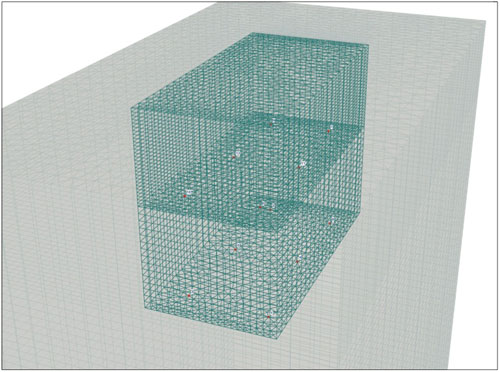Dimensioning of the field test site
Before we start with the construction of the experimental unit at our institute in Pirna we decided to model the site in order to find the optimal dimensions and layout of the planned infiltration trench. This will give us the possibility to use several soils and different infiltration methods. The experimental setup will include, apart from the infiltration trench itself, a climate tent to control the atmospheric boundary conditions and a set of groundwater observation wells.

For the preliminary modeling of the test field site, a 3D model was build with the software HYDRUS 2D/3D, a Microsoft Windows based modeling environment for the analysis of water flow and solute transport in variably saturated porous media. At first, the dimensions of the infiltration trench were observed with the goal of designing a maximum sized infiltration unit. The limiting factor was the possible influence of the rainwater from outside the tent on the subsurface soil zone underneath the control area protected by the tent. The simulations aimed at gradually reducing the size of the trench in order to avoid the access of the outside precipitation into the trench body. This goal could not be reached, as model results continuously showed seeping of the precipitation into the infiltration trench. This leads us to bringing one improvement in the design of the trench by introducing steel piling into the test site for hindering the horizontal seeping into the trench and thus defining more controllable boundary conditions for the model. Considering these design assumptions, the surface area of the infiltration trench was then set to 1m x 2m.
Further simulations aimed at finding an appropriate design depth considering a vertical distribution of the measurement sensors on two layers. Two variable depths were simulated (at 2m and 1.5m below soil surface) but a comparison of water content trends in both depths showed visible but rather insignificant differences. Therefore the final dimensions of the trench were set to 1m x 2m x 1.5m. Further investigations included the allocation of the measuring devices on the two layers, one in the middle of the trench and one at the bottom.
After setting the basic properties of the infiltration trench, a sensitivity analysis will be conducted next considering different infiltration rates (in terms of quantity and time duration), as well as different soil types and climate scenarios.